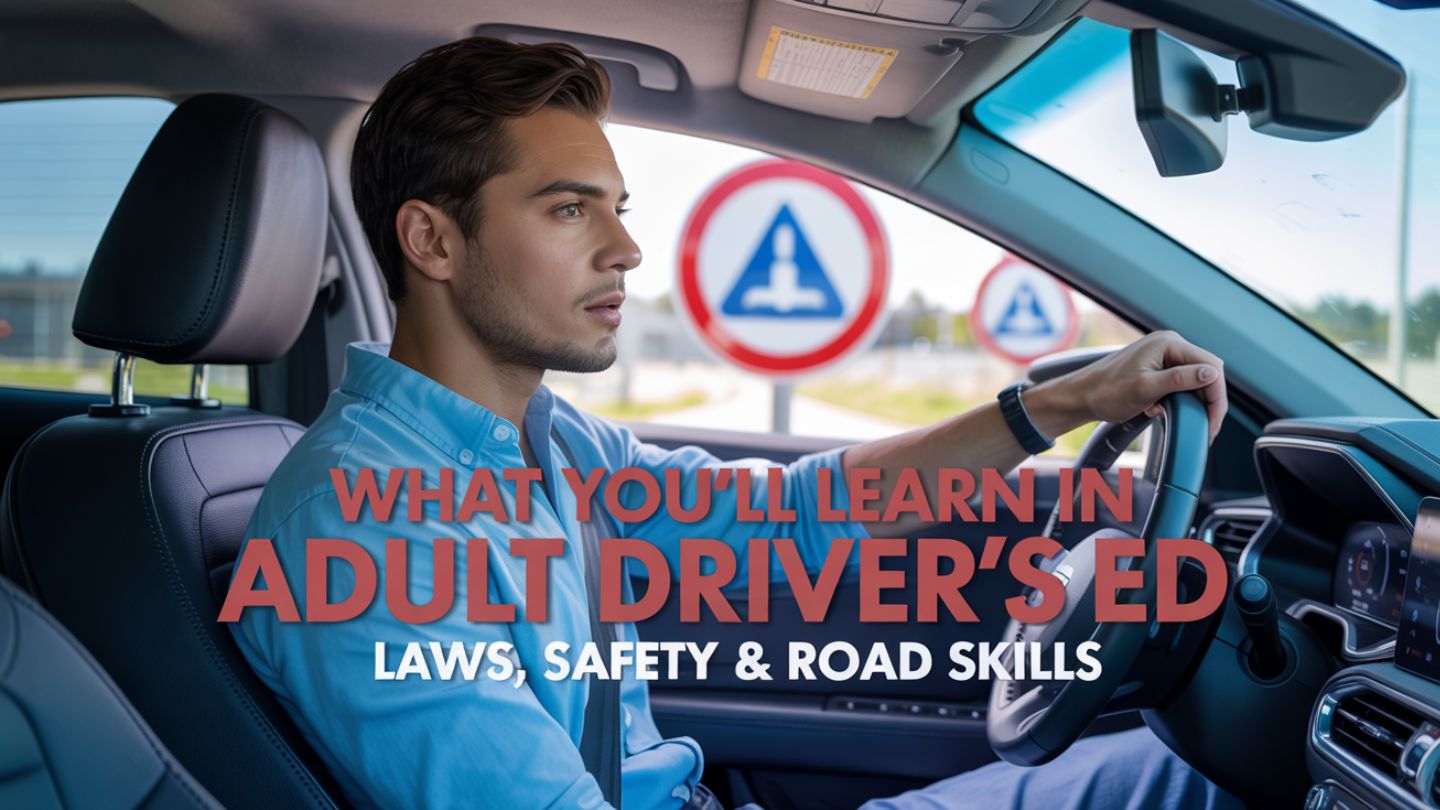In adult driver’s ed, you’ll master traffic laws, learn how to stay safe on the road, and develop essential driving skills. These courses offer practical training and insights to help you drive confidently and legally. This blog breaks down what you’ll learn in adult driver’s ed: laws, safety, and road skills.
Key Takeaways
- Adult driver’s education equips you with essential traffic laws, defensive driving techniques, and hands-on experience to ensure safety and confidence on the road.
- Understanding state-specific regulations and general rules of the road is critical for avoiding legal issues and fostering responsible driving habits.
- Practical driving experience and consistent tracking of your progress are vital for mastering driving skills and successfully passing your permit and road tests.
Introduction
Adult driver’s education is designed to provide a thorough understanding of traffic laws, safety protocols, and essential road skills. You’ll learn about state-specific regulations, the rules of the road, and the legal consequences of traffic violations. The program also covers defensive driving techniques to help you anticipate and avoid potential hazards.
Additionally, you will gain hands-on experience in vehicle handling and control, ensuring you are prepared for various driving conditions. Upon completing the course, you’ll be knowledgeable in safe driving practices, prepared to pass your permit test, and confident in navigating the roads as a licensed driver.
Many adults find themselves needing to learn how to drive later in life. Whether it’s due to moving to a new country, a change in personal circumstances, or simply never having had the opportunity before, adult driver’s education is here to assist. These courses are specifically designed to cater to adults, providing a flexible and comprehensive learning experience that fits into your busy schedule. The goal is to equip you with the skills and knowledge necessary to be a safe and confident driver.
Understanding the adult driver education FAQs can simplify the process for first-time adult learners in Texas. From age requirements to course duration, this guide covers all the essential questions adults typically ask before enrolling in a certified driver’s ed program.
Adult driver’s ed programs offer a range of options, including online courses and in-person training, to ensure you have access to the resources you need. These programs typically include classroom instruction, practical driving lessons, and supervised practice sessions, all aimed at helping you pass your permit and road tests with flying colors. Adult driver’s education is an essential part of this process.
Completing the course will equip you with the confidence and skills needed to navigate the roads safely and effectively, irrespective of your age or previous driving experience.
Understanding Traffic Laws

A fundamental aspect of adult driver’s education is understanding traffic laws. These laws are in place to ensure the safety of all road users and to maintain order on the roads. As an adult driver, it is crucial to familiarize yourself with these regulations to avoid legal consequences and ensure safe driving practices.
Taking driver’s education as an adult offers more than just a path to licensing; it builds confidence, refreshes road knowledge, and ensures legal compliance. Whether you’re a new driver or returning to the road, adult education programs provide the structure needed for success.
This section will delve into state-specific regulations, the general rules of the road, and the potential legal consequences of violating traffic laws.
State-Specific Regulations
Traffic laws can vary significantly from state to state. In Texas, for instance:
- Individuals aged 18 to 24 must take an adult driver’s education program when applying for their first driver’s license.
- The Texas Adult Driver Education course is state-approved.
- The course lasts for six hours.
- It can be taken online.
Understanding these state-specific regulations is essential for ensuring compliance and avoiding any legal issues.
Rules of the Road
The rules of the road are designed to maintain order and safety. Key rules include:
- Understanding right-of-way at intersections
- Adhering to speed limits
- Following traffic signals and road signs.
These rules are essential for preventing accidents and ensuring a smooth flow of traffic.
As an adult driver, mastering these rules is crucial for safe and responsible driving.
Legal Consequences
Violating traffic laws can lead to severe legal consequences, including a traffic ticket. Penalties may include monetary fines, points on your driver’s license, and even mandatory court appearances. Serious violations can result in higher insurance premiums and additional penalties.
Understanding these potential consequences is vital for maintaining a clean driving record and ensuring long-term driver safety.
Defensive Driving Techniques

Defensive driving is all about being proactive and anticipating potential hazards on the road. This approach to driving helps prevent accidents and enhances overall driver safety through a defensive driving course.
In this section, we will explore essential defensive driving techniques, including anticipating potential hazards, maintaining safe following distances, and handling emergency situations.
Anticipating Potential Hazards
Anticipating potential hazards involves constantly scanning the road ahead and being aware of the behavior of other drivers. This proactive approach allows you to identify early warning signs and react accordingly. For example, covering the brake when approaching high-risk areas can help you respond quickly to unexpected situations.
Staying alert and prepared greatly reduces the risk of accidents and enhances driver safety. Remember to stay safe.
Safe Following Distances
Maintaining a safe following distance is crucial for preventing rear-end collisions. A safe distance of three to four seconds allows you enough time to react to sudden stops or changes in traffic conditions. This practice is especially important in adverse weather conditions, where stopping distances can be longer.
Maintaining a safe distance improves your ability to respond effectively to sudden changes in traffic and promotes safe driving practices.
Handling Emergency Situations
Emergency situations, such as skidding or brake failure, require calm and controlled responses. If your vehicle starts to skid, follow these steps:
- Remain calm.
- Look where you want to go.
- Steer gently in that direction.
- Avoid slamming on the brakes, as this can worsen the skid.
In case of brake failure, pump the brake pedal to build up pressure and try to slow down. If pumping the brakes doesn’t work, shift to a lower gear to use engine braking. Staying calm and knowing how to handle emergencies can significantly enhance driver safety.
Vehicle Handling and Control

Mastering vehicle handling and control is essential for confident and safe driving. This section will cover the basics of vehicle operations, advanced maneuvering techniques, and how to drive in various conditions.
By understanding how your vehicle responds to different inputs, you can ensure smoother and safer driving experiences.
Basic Vehicle Operations
Basic vehicle operations include understanding how to start the engine, brake smoothly, and steer the vehicle safely. Mastering these fundamental controls is essential for safe driving.
For instance, knowing how to execute smooth stops and safe turns can significantly reduce the risk of accidents.
Advanced Maneuvering
Advanced maneuvering techniques, such as parallel parking and three-point turns, are crucial for navigating tight spaces and complex driving scenarios. These skills require practice and precision to execute smoothly and efficiently in real-world situations.
Mastering these maneuvers enhances overall driving skills and boosts confidence.
Driving in Various Conditions
Driving in different weather and traffic conditions requires adjustments in driving techniques. For example, in rain or snow, increasing your following distance and reducing speed can enhance safety.
Understanding how to adapt to various conditions is essential for preventing accidents and ensuring convenient, safe driving.
Safe Driving Practices
Adopting safe driving practices is at the core of adult driver’s education. These habits not only protect you but also ensure the safety of other road users.
This section will cover essential safe driving practices, including avoiding distracted driving, being aware of alcohol and drug effects, and the importance of wearing seat belts.
Avoiding Distracted Driving
Distracted driving is a leading cause of accidents. Common distractions include mobile phone use, eating, and adjusting vehicle controls. Minimizing these distractions is crucial for maintaining focus on the road.
Staying attentive and avoiding distractions significantly enhances driver safety.
Alcohol and Drug Awareness
Driving under the influence of alcohol or drugs impairs judgment and reaction times, making it a critical safety issue. Understanding these effects is essential for ensuring road safety.
Sober driving is vital for preventing accidents and protecting lives.
Importance of Seat Belts
Wearing seat belts is crucial for reducing the risk of severe injuries during an accident. Seat belts significantly decrease the likelihood of injury in a collision.
Consistently wearing seat belts ensures maximum safety for all vehicle occupants.
Preparing for the Permit Test
Preparing for the permit test is a critical step in obtaining your driver’s license. This section will guide you through the process, including study materials, practice tests, and test day tips.
Following these guidelines will ensure you’re well-prepared to pass the permit test and continue your journey toward becoming a licensed driver.
Study Materials
Accessing the right study materials is essential for effective preparation. Online driver education courses in the Texas Department offer the advantage of convenience, allowing you to study from anywhere at any time. These courses typically include comprehensive materials that cover all aspects of the written test.
Utilizing these resources will effectively prepare you for the permit test.
Practice Tests
Practice tests are invaluable for reinforcing your understanding of traffic laws and safe driving practices. They help evaluate your knowledge and readiness for the permit exam. Additionally, a free study guide is often available to further aid your preparation.
Incorporating practice tests into your study routine can significantly enhance your chances of passing the exam on the first try.
Test Day Tips
On the day of the permit test, consider the following to help ensure success:
- Arrive early to reduce stress and ensure a smooth check-in process.
- Practice relaxation techniques, such as deep breathing, to maintain composure during the test.
- Ensure that all necessary documents and identification are in order before arriving.
Practical Driving Experience
Gaining practical driving experience is a cornerstone of adult driver’s education. Practical sessions allow you to put theoretical knowledge into practice, enhancing your driving skills and confidence.
This section will cover the benefits of behind-the-wheel training, the importance of supervised practice, and how to track your progress effectively.
Behind-the-Wheel Training
Behind-the-wheel training is essential for new drivers as it provides the practical experience needed to navigate the complexities of driving. These training sessions allow learners to practice in a controlled environment, significantly enhancing their driving confidence.
Completing the training prepares individuals not only for the driving test but also for everyday driving encounters on the train.
Supervised Practice
Supervised practice with a licensed driver is crucial for reinforcing the skills and knowledge gained in driver’s education courses. Techniques like parallel parking and three-point turns require practice to master, and having an experienced driver to guide you can make a significant difference.
Regular supervised practice sessions help you become more comfortable and proficient in various driving scenarios.
Progress Tracking
Tracking your progress in driver’s education is essential for identifying skills you have mastered and those that require more attention. Behind-the-wheel training sessions provide measurable milestones that help track your improvement in various driving skills.
Consistent feedback from supervised practice sessions can further refine your driving abilities, ensuring you are well-prepared for the road test and everyday driving challenges.
Programs with flexible scheduling in adult driver education allow working adults to balance training with busy personal and professional responsibilities. Evening classes, online modules, and self-paced coursework make it easier than ever to meet state requirements on your terms.
Completion and Certification
Completing the adult driver’s education course is a significant milestone on your journey to becoming a licensed driver.
This section will discuss the overall duration of the course, the process of obtaining your certificate of completion, and the next steps you need to take to schedule your road test.
Course Duration
The total time commitment required for the driver’s education course typically involves a minimum of 30 hours of classroom instruction and 18 hours of on-road training. After the first six hours of driver education, students can expect to receive their certificate of completion, which is a crucial step towards scheduling the road test.
This structure ensures that learners have ample time to grasp both theoretical and practical aspects of learner-permitted driving.
Certificate of Completion
Upon successful completion of the adult driver’s education course, a certificate is provided that is available for download. This certificate is essential for obtaining a driver’s license, as it verifies that the individual has completed the required educational training.
The online driving education course allows students to receive a PDF certificate that can be printed at any time, adding to the convenience of the learning process for online drivers.
Next Steps
After completing the driver’s education course, the next step is to schedule and pass the road test to obtain your driver’s license. It’s important to schedule your road test with the local Department of Motor Vehicles to ensure you secure a spot.
Avoid delays and rejections by learning the mistakes to avoid in adult driver education. From missing documents to overlooking state deadlines, the common pitfalls can help the adult learners streamline their certification process with confidence.
Completing this first step will officially make you a licensed driver, ready to hit the road with complete confidence and safety, armed with your driver’s license and understanding the importance of licensing.
Final Thoughts
Adult driver’s education delivers a complete framework for mastering traffic laws, developing safe driving habits, and building real-world vehicle control skills. This blog outlined key takeaways from defensive driving techniques and legal compliance, to understanding permit test preparation and practical training. Designed with flexibility in mind, these courses empower adults to approach driving with competence, confidence, and responsibility.
At Easy Drivers Ed, our Texas adult driver’s education course is tailored to meet state requirements while offering the convenience of online learning. With self-paced modules, certified instruction, and downloadable certificates, our program provides the tools adults need to earn their license and drive with assurance across Texas.
Frequently Asked Questions
What is the benefit of the online driving education course regarding the certificate?
You can easily obtain a PDF certificate from the online driving education course, which you can print whenever you need it. This convenient access helps you stay organized and prepared for your driving tests or requirements!
When can individuals start their online driver education in Texas?
You can start your online driver education in Texas as soon as you meet the state’s age eligibility criteria. Don’t wait, get started on your journey to becoming a safe and confident driver today!
What is the primary advantage of taking drivers education online in Texas?
The primary advantage of taking driver’s education online in Texas is the convenience of learning from anywhere and at any time, allowing you to fit your education into your busy schedule seamlessly. Embrace this flexibility to become a confident driver!
What is the cost of the Adult Drivers Ed course in Texas?
The Adult Drivers Ed course in Texas costs $30.00, making it an affordable step towards gaining your independence on the road! Don’t miss this opportunity to start your journey!
How long does it take to receive a certificate of completion for the drivers ed courses?
You can expect to receive your certificate of completion promptly after completing the first 6 hours of your driver education course. Stay focused, and you’ll be one step closer to hitting the road!

